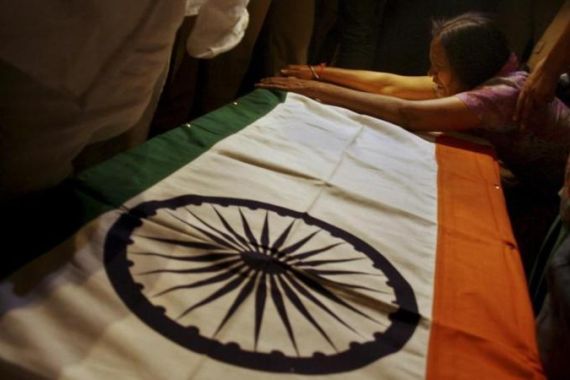India-Pakistan spy games take deadly turn
Recent death of two prisoners highlight plight of poor men caught up in distrust between nuclear rivals.

For someone who spent a lonely life in a Pakistani jail for more than two decades of his life, the public farewell that Sarabjit Singh received on his death was rather remarkable.
After news broke that Singh – held by Pakistan since 1990 for allegedly being a spy and plotting two bomb attacks that killed 14 – had succumbed to his injuries after being beaten by fellow inmates, anger and outrage swept India. Stung by the mood on the street, the government organised a state funeral for him – televised live after a visibly embarrassed Pakistan sent back his body.
There were other consequences as well: Sanaullah Ranjay, a Pakistani prisoner being held in an Indian jail in the state of Jammu and Kashmir for allegedly being behind a 1994 bus bombing was also assaulted by fellow prisoners in an apparent revenge attack. He died on May 8.
The grisly deaths further frayed already tense ties between nuclear-armed rivals India and Pakistan. The deaths also shone the spotlight on the fate of prisoners from both countries being held across the border, who had previously been all but forgotten by their respective countries of origin.
Jailing ‘spies’
According to Indian government authorities there are 535 Indian prisoners, including 483 fishermen, imprisoned in Pakistani jails, while 272 Pakistani prisoners remain in Indian jails.
There are no official numbers available on how many of them are classified as spies. But it seems Singh’s fate was sealed after India hanged both Mohammed Ajmal Qasab, a Pakistani gunman involved in the 2008 Mumbai attacks, and Afzal Guru, a resident of Indian-administered Kashmir for the 2001 attack on India’s parliament.
Awais Sheikh, Singh’s lawyer, told reporters that his client had “received threats after Afzal’s execution”.
As the grim ends faced by Singh and Ranjay illustrate, the life – and death – of an alleged spy is often sordid. They are often disowned once they get caught. And once in captivity, they evoke hatred.
Lawyers representing prisoners have much to say on how the two governments handle their prisoners.
They have complained in the past that both Indian and Pakistani authorities do not allow access to prisoners.
Amnesty International in New Delhi, in a bid to abolish the death penalty, has requested the two governments establish an official moratorium on executions.
An unrecorded saga
The deaths of Singh and Ranjay have led to a public debate in India about the state of spies sent to Pakistan.
Shastri Ramachandran, an independent political and foreign affairs commentator wrote about how the “vulnerable community of spies who serve India are dumped once they are caught, exposed or when they cease to be useful”.
Spies recruited by the armed forces, the Intelligence Bureau, and the RAW (Research & Analysis Wing) who have been caught and “suffer in Pakistani prisons are the worst victims of callous neglect”, Ramachandran alleged. “[These] brave men are not only unsung and unrecognised, but condemned to death, dishonour and/or poverty”.
Unsurprisingly, given the allegations, neither prisoners nor their families usually admit to spying.
Singh and his family, for example, maintained that he was a farmer who simply wandered across the border.
Many of the men recruited for espionage are thought to hail from poor families, and are often unaware of the dangers that lie ahead.
Emboldened by the state honours Singh received, several poor Indian spies are now hoping for compensation for the torture and suffering they say they underwent in Pakistani prisons.
Chandigarh-based lawyer Rajan Lakhanpal has so far filed some 40 petitions in Punjab and Haryana courts on behalf of former spies.
He agreed that, despite the petitions, there has not been much monetary help for these men – as the government might view compensation as an acknowledgement of espionage work undertaken.
Following Singh’s death, Indian media have been highlighting stories of former spies, such as Kashmir Singh – who apparently never received compensation after spending two decades in a Pakistani prison.
Prison welfare
According to Syed Akbaruddin of India’s foreign ministry, both nations need to “ensure the safety, security and humane treatment of Indian and Pakistani prisoners in each other’s jails”.
Following the protests over Singh’s attack, a five- member team of the India-Pakistan Judicial Committee on Prisoners visited Pakistani jails in Karachi, Rawalpindi and Lahore.
Since January 2012, 684 fishermen and 30 “civilian prisoners” were released by Pakistan. Indian authorities released 96 Pakistani fishermen and 59 Pakistani “civilian prisoners”.
In Karachi’s Jail Malir district, there are apparently 29 Indian prisoners who completed their sentence more than a month ago.
The committee recommended their release and repatriation before the end of May. The committee also proposed recommendations for better management of prisoners between the countries. These included providing detainees with consular access within three months of arrest.
In Kot Lakhpat Jail in Lahore, 20 prisoners were found to be mentally ill. The joint committee has requested that their medical reports and photographs be shared with the High Commission of India, so that efforts could be renewed to confirm their nationality. The committee is scheduled to meet again in September 2013 for a review of their recommendations.
Hopefully the steps being mooted would improve the plight of the prisoners, including those held on suspicion of spying.